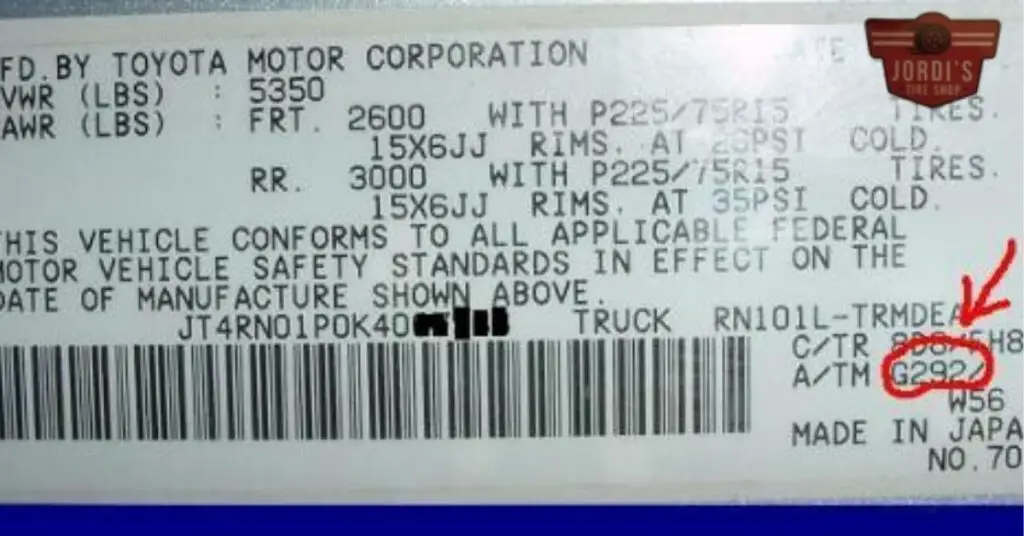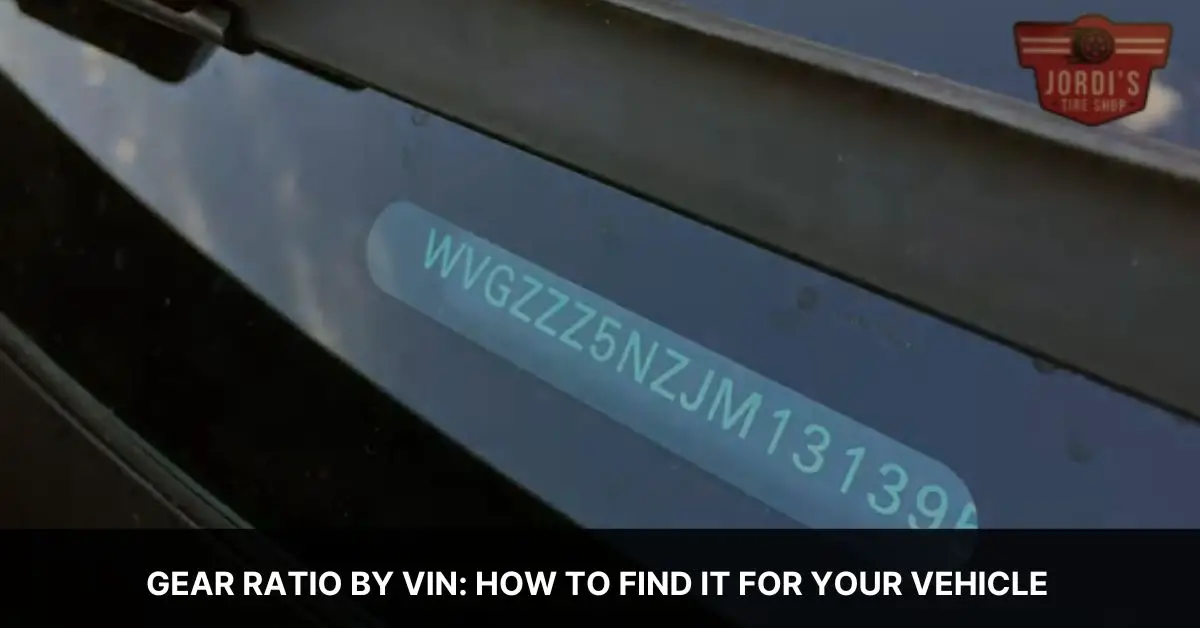Ever wondered why some cars zip through the streets with seemingly effortless grace while others chug along, struggling to keep pace? A lot of that has to do with what’s under the hood, specifically the gear ratio. But did you know you can unlock this piece of automotive mystery with something as simple as your vehicle’s VIN? That’s right, that long string of numbers and letters isn’t just a random sequence; it’s a goldmine of information about your car, including its gear ratio.
Understanding your car’s gear ratio can significantly impact its performance, fuel efficiency, and how it handles the road. Whether you’re a gearhead looking to tweak your ride or a curious owner aiming to understand your vehicle better, we’re here to guide you through the ins and outs of finding and interpreting your car’s gear ratio by VIN. Let’s dive into this fascinating aspect of automotive anatomy together, shall we?
Understanding Gear Ratio by VIN

Diving deeper into how one can decipher the gear ratio from a Vehicle Identification Number (VIN) opens up a fascinating pathway to appreciating automotive engineering. Essentially, the VIN is a unique code specific to each vehicle, containing information about the car’s country of origin, manufacturer, and other key details, including aspects related to its transmission and hence, gear ratio.
To begin, it’s crucial to locate the VIN, typically found on the driver’s side dashboard or the driver’s side door frame. Once we have the VIN, the next step involves decoding it. While the full VIN provides a wealth of information, specific positions within this 17-character code are especially relevant for uncovering gear ratio details.
Decode services, both online platforms, and dealership databases, make the process straightforward. By entering the VIN into these services, one can access detailed vehicle specifications. The transmission type and specifications, including the gear ratio, are usually part of this information. However, it’s worth noting that not all online tools provide gear ratio details directly; some may only indicate the type of transmission.
Manufacturers sometimes embed the gear ratio information within a subset of the VIN or provide it in accompanying documentation. If online tools don’t suffice, contacting a dealership with the VIN can help. Dealerships have comprehensive databases and can provide precise gear ratio details based on the VIN. Additionally, manufacturer customer service lines are another valuable resource for obtaining this information.
Understanding the gear ratio provides insight into how the vehicle transfers power from the engine to the wheels, affecting acceleration, fuel efficiency, and overall performance. Armed with the VIN and knowing how to navigate the details it holds, we’re equipped to delve into the mechanical heart of our vehicles, ensuring a more informed ownership and enhanced driving experience.
The Importance of Gear Ratio in Vehicle Performance

Understanding the gear ratio of a vehicle is crucial for several reasons, each impacting the driving experience in unique ways. We’ve already touched upon how decoding a Vehicle Identification Number (VIN) can reveal a car’s gear ratio, showcasing its significance in a vehicle’s transmission and overall design. Now, let’s dive into why this piece of information is so valuable for vehicle performance.
Firstly, gear ratios determine a car’s acceleration capabilities. A lower gear ratio means the car can accelerate more quickly, providing that instant response and power drivers often desire, especially in performance vehicles. This aspect is particularly noticeable during take-off and when overtaking on highways.
Secondly, the gear ratio plays a pivotal role in fuel efficiency. Higher gear ratios, although not conducive to quick acceleration, can lead to better fuel economy. This is because the engine runs at lower RPMs (revolutions per minute) for the same speed, consuming less fuel over time. Therefore, drivers looking to maximize their fuel efficiency without a significant need for speed might prefer a vehicle with a higher gear ratio.
Thirdly, towing capacity is directly influenced by the gear ratio. Vehicles intended for towing heavy loads usually have a lower gear ratio. This setup provides more torque at the wheels, making it easier to pull weight without overstressing the engine. For anyone using their vehicle for hauling trailers, boats, or any substantial load, knowing the gear ratio is essential for determining towing capabilities.
Lastly, driving comfort and experience are affected by the gear ratio. A carefully balanced gear ratio can ensure smoother transitions between gears, less engine noise at high speeds, and an overall more pleasant driving experience. This balance between power, fuel economy, and comfort is what makes understanding gear ratios so crucial for car enthusiasts and everyday drivers alike.
By considering the gear ratio, as uncovered by a vehicle’s VIN, drivers can gain insights into acceleration, fuel efficiency, towing capabilities, and overall driving comfort. Such knowledge not only enriches the driving experience but also allows for informed decisions regarding vehicle performance and maintenance.
Finding Your Vehicle’s Gear Ratio
Discovering the gear ratio of your vehicle doesn’t have to be a complex process. The VIN (Vehicle Identification Number) offers a direct path to this valuable information. Here, we’ll guide you through a straightforward method to locate your car’s gear ratio using its VIN, further enhancing your understanding of your vehicle’s performance and efficiency.
First, locate your vehicle’s VIN, typically found on the dashboard on the driver’s side, visible through the windshield, or inside the door jamb on the driver’s side. This unique 17-character code not only identifies your vehicle but also encodes specific details about it, including the gear ratio.
Next, accessing the gear ratio through the VIN requires a reputable VIN decoder. Several online tools and websites allow you to input your VIN and receive a detailed breakdown of your vehicle’s specifications, including the gear ratio. These decoders translate the complex information embedded within your VIN into understandable data, detailing aspects such as engine size, transmission type, and, pivotally, gear ratio.
For those seeking a more direct approach, contacting the vehicle’s manufacturer or authorized dealer provides another reliable avenue. With your VIN at hand, a representative can retrieve your vehicle’s detailed specifications directly from their database, including the precise gear ratio. This method ensures accuracy and provides an official source for your vehicle’s information.
Lastly, examining the vehicle’s manual or service records might reveal the gear ratio. Manufacturers often include this information within the vehicle documentation or encode it in a label affixed to parts of the vehicle, such as the rear axle or transmission case.
Common Mistakes to Avoid When Looking Up Gear Ratio by VIN

In our efforts to understand the intricacies of our vehicles better, we often look for detailed specifics, such as gear ratios, using the VIN. While this approach yields valuable insights, there are common pitfalls we should sidestep to ensure accuracy and efficiency in our search.
Relying Solely on Generic Online Decoders
One prevalent mistake is relying entirely on generic online VIN decoders. While these tools offer convenience and immediate results, they may not always provide the most accurate or detailed information regarding gear ratios. It’s imperative to cross-reference data or consult more specialized tools or sources.
Not Double-Checking With Dealers or Manufacturers
Skipping the step of verification with dealers or manufacturers is another error. Even if an online tool or database gives us an initial answer, dealers or manufacturers can offer the most accurate and up-to-date information directly tied to our VIN.
Ignoring Service Records and Manuals
Overlooking the vehicle’s service records or manual is a common oversight. These documents often contain detailed information specific to our car, including the gear ratio. Disregarding these resources means potentially missing out on readily available and accurate data.
Misinterpreting the Information
Misinterpreting the information derived from the VIN can lead us astray. Gear ratios, for instance, may vary based on other vehicle specifications or options. It requires a comprehensive understanding of not just the numbers but their context within the vehicle’s overall configuration.
Assuming All Models Have the Same Gear Ratios
Assuming that all models or years of a specific car have the same gear ratios is a misconception to avoid. Variations in production runs, special editions, or different markets can result in different gear ratios, and assuming uniformity can lead to incorrect conclusions.
Real-Life Applications of Knowing Your Gear Ratio

Understanding your car’s gear ratio, as obtained through the Vehicle Identification Number (VIN), unlocks several practical benefits that enhance driving experience and vehicle management. This knowledge isn’t just a piece of technical trivia; it plays a crucial role in various real-life applications.
Optimizing Performance
Firstly, knowing the gear ratio allows drivers to optimize their vehicle’s performance according to their driving needs. For example, those who prefer quick acceleration might opt for a lower gear ratio. This setting provides more torque to the wheels, making the car faster off the line. Conversely, higher gear ratios benefit drivers looking for higher top speeds or improved fuel efficiency during long highway drives.
Upgrading and Customization
For enthusiasts interested in customizing or upgrading their vehicles, understanding the existing gear ratio is essential. When modifying a car for specific tasks, such as drag racing or off-roading, the gear ratio can significantly impact its effectiveness. Choosing the right ratio ensures the modifications deliver the desired performance. This customization might involve switching to a gear set that offers quicker acceleration for competitive racing or a set that provides better traction and power management for off-road adventures.
Towing and Hauling
Drivers who frequently tow or haul heavy loads benefit greatly from knowing their vehicle’s gear ratio. A lower gear ratio increases the towing capacity by providing more power to overcome the additional weight. This knowledge helps in selecting a vehicle that meets towing needs without risking damage or underperformance. It’s also useful for planning trips that involve towing, as drivers can adjust their expectations and preparations based on their vehicle’s capabilities.
Purchasing Decisions
Finally, when purchasing a new or used vehicle, understanding gear ratios and their implications on performance and fuel economy can inform buying decisions. Prospective buyers can look up the gear ratio by VIN to get an accurate understanding of how a vehicle will perform in terms of acceleration, fuel efficiency, and towing capacity. This information leads to more informed and satisfactory vehicle choices, matching the buyer’s specific needs and preferences.
Conclusion
We’ve explored how crucial a car’s gear ratio is to its overall performance and how it affects everything from acceleration to fuel economy. By learning to find this ratio through your car’s VIN, you’re taking a big step toward not just understanding your vehicle better but also enhancing how you interact with it. Whether it’s about making your ride more suited for specific tasks or ensuring you’re making the best choice when it comes to fuel efficiency and towing capabilities, the gear ratio is a key piece of the puzzle. Let’s use this knowledge to drive smarter and enjoy our journeys to the fullest.
Related Posts:
- Best Winter Tires for Honda Civic: Top Picks for Safe and Smooth Driving in Cold Weather
- Check Engine Light Goes Off By Itself: What It Means and What to Do
- Difference Between Tire and Wheel: A Simple Explanation
- Volt Propulsion Power Reduced: Causes and Solutions
- F150 Blend Door Actuator Reset: Quick and Easy Steps
- Supercharged Scat Pack: The Ultimate Muscle Car Upgrade
- Sys Off to Save Battery: Simple Tips to Extend Your Device’s Battery Life
- Suspension Tuning Car: Tips for Improving Your Ride Quality
- Gear Ratio by VIN: How to Find It for Your Vehicle
- Engine Wash: How to Keep Your Vehicle Running Smoothly

